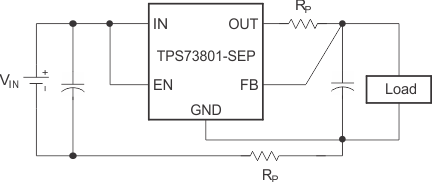SLVSER5A December 2018 – May 2021 TPS73801-SEP
PRODUCTION DATA
- 1 Features
- 2 Applications
- 3 Description
- 4 Revision History
- 5 Pin Configuration and Functions
- 6 Specifications
- 7 Detailed Description
- 8 Application and Implementation
- 9 Power Supply Recommendations
- 10Layout
- 11Device and Documentation Support
- 12Mechanical, Packaging, and Orderable Information
Package Options
Mechanical Data (Package|Pins)
- DCQ|6
Thermal pad, mechanical data (Package|Pins)
Orderable Information
7.3.2 Fixed Operation
The TPS73801-SEP can be used in a fixed voltage configuration. By connecting the FB pin to OUT, the TPS73801-SEP will regulate the output to 1.21 V. During fixed voltage operation, the FB pin can be used for a Kelvin connection if routed separately to the load. This allows the regulator to compensate for voltage drop across parasitic resistances (RP) between the output and the load. This becomes more crucial with higher load currents.
 Figure 7-2 Kelvin Sense Connection
Figure 7-2 Kelvin Sense Connection